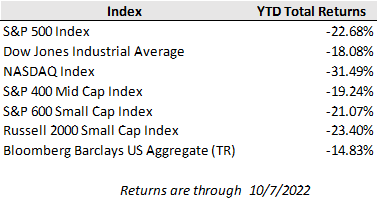Hopes that the Fed and other central banks would begin to pull back on their aggressive hawkish stance in the fight against inflation spurred investors to buy into equities across Monday and Tuesday, after a glum end to Q3. But those expectations were sharply tempered after Friday's payroll data indicated that the central bank would not stray from its rate-hiking policies. Stocks dropped Friday after the latest government data showed a continued strong U.S. labor market that likely ends any doubt that the Federal Reserve will maintain its aggressive policy of raising interest rates. Nonfarm payrolls increased 263,000 in September after a 315,000 gain in August, and the unemployment rate dropped to 3.5%, matching a 50-year low. Friday’s market losses trimmed the gains for what started out as a big comeback week for stocks, with the Dow Jones rising 2% for the week, the S&P advancing 1.5%, and the Nasdaq adding 0.7%. Eyes will be on the Fed's September meeting minutes scheduled for release next week for more details on the central bank's thinking.
Third quarter corporate earnings season will kick off in the week ahead with PepsiCo and Delta Air Lines and the big banks set to report results. Investors’ big fear: companies will reveal that the combination of inflation, slowing economic growth, and a strong dollar has eaten into profits.
It’s a mixed picture. Just 65 companies in the S&P 500 have warned that third-quarter results are likely to disappoint, according to FactSet, while 41 companies have delivered earnings upgrades. And S&P 500 companies are expected to report that on average, revenue jumped by nearly 9% last quarter. But profits are only expected to grow by 2.4%, the most lackluster increase since the worst days of the Covid pandemic in 2020.
Almost all the earnings growth is coming from the energy sector. Of the 11 sectors in the S&P 500, only four — energy, industrials, real estate and consumer discretionary industries like restaurants and hotels — are expected to show overall growth. The bottom lines of energy companies are expected to jump an average of 117% versus a year ago, which is the biggest increase of any sector. Without the 21 energy companies in the S&P 500, the bottom lines of the remaining companies would drop, by 4.2% on average, according to FactSet. Although the recent rise in the dollar is a big plus to U.S. travelers, it’s bad news for exports, which make up about 40% of sales for S&P 500 companies. A strong dollar means American goods are more expensive to overseas buyers, and less profitable back home when foreign revenues are converted into dollars.



